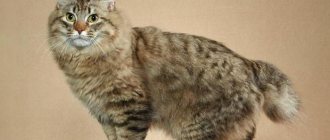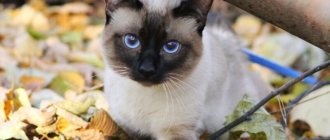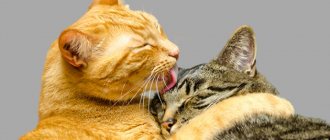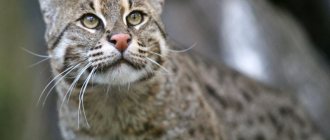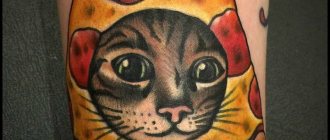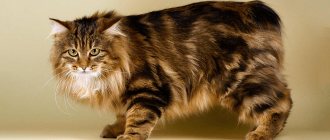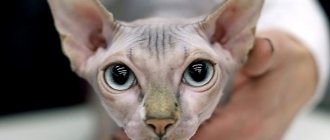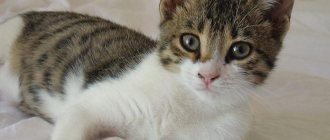In each country, cats of certain breeds are revered. The Russian Blue cat is considered the pride of Russian breeders, the most revered cat in England is the British Shorthair, and in Japan the Japanese Bobtail, an amazing cat with an unusually short tail, is highly recognized. There are many legends about this representative, but the most important thing is that he is considered a real symbol of good luck!
We invite you to take a closer look at Japanese Bobtail cats, which have an incredibly long history of origin. The first mentions date back to the 15th century. In the late 70s of the 20th century, short-haired Japanese bobtails were officially recognized, and long-haired ones only 20 years later.
History of the breed
It is believed that short-tailed cats were brought to Japan by sailors from India through China in the 10th century AD. So the Japanese Bobtail has an ancient pedigree - it is already more than 1000 years old. The Japanese believed that tailless cats could ward off evil spirits and attract good luck.
The Japanese loved and valued their pets, this is evidenced by the images of tailless cats in ancient engravings and paintings, their images can also be seen in the Gotokuju Temple in Tokyo, and the “maneki-neko”, or “greeting cat” - a cat figurine with a raised paw - is very a popular souvenir in Japan that can be seen in many shops and stores.
Foreigners only saw these unusual cats in the 20th century, when they began coming to Japan after World War II. Residents of the United States were the first to appreciate the attractiveness of Japanese bobtails, and today in America the largest number of nurseries are engaged in their breeding. The breed was officially recognized in the states in 1976, and internationally in 1990. Crossing cats of this breed with others is prohibited.
Both in Russia and in European countries little is known about the Japanese bobtail; the breed is not among the popular and numerous. Meanwhile, the character of these cats is such that any of them will become a wonderful friend, loving and very attached to the owner.
Characteristics of the Japanese Bobtail
The character of cats from the Land of the Rising Sun deserves special attention. They become very attached to the owner, to the family, and want to take part in everything that happens in the house. They get along well with children and never offend children. These pets are talkative; many owners say that they do not meow, but “sing.” Their voice is not as low and hoarse as that of Siamese cats and is slightly lower than that of European cats we are accustomed to.
Both kittens and adults are very mobile and active. In the past, excellent hunters of mice and other rodents, they will find something to do in the apartment - they will happily play with the owner with a toy prey mouse, run after flies, chase candy wrappers.
Japanese bobtails are very inquisitive, enjoy learning new things, and are easy to train. This is an animal for those who want to have an active, active, curious and devoted pet. If you like to sit in front of a computer or TV, and an active lifestyle is alien to you, a guest from Japan will be bored with you.
In addition to humans, bobtails also love the company of their own kind. If you have a desire to have two or three pets, they will definitely not be bored and will always find something to do.
Japanese Bobtails get along well with dogs. Probably because there is quite a bit of “dog” in their character - they love to carry various objects in their teeth, like a fetch dog, play tug of prey with their owner, many individuals love to swim. They follow commands well, walk on a leash, and the cat can be taught to fetch different things.
As an owner, a native of Japan chooses one family member to whom he will be faithful like a dog. If you dreamed of a dog, but for some reason were unable to get one, this amazing cat will turn out to be no less loyal and smart.
Due to its developed intelligence, a pet can get into an unpleasant situation, it is better not to let it go for a walk on its own, and come up with interesting activities for it. Like an active dog, without enough exercise, behavior problems can arise that can then be difficult to correct.
Cats of this breed can be handled in almost the same way as dogs. They study with pleasure, pay attention to their owner, and love walks. Reward for following commands can be a treat or a favorite toy.
It is very interesting to watch these cats; they become very excited when their favorite toy or new object appears. But most of all they like active games with the participation of the owner. They treat strangers with caution, but without fear or aggression. Easily meet new people and animals.
The Bobtail is not just a cat, it is a devoted friend and companion, a hunter and athlete who loves walks; with such a friend you can have an active holiday.
Education and training
High intelligence allows you to teach cats several tricks, but at this moment they must be in a good mood. The main thing is to captivate the fluffy beauty, and then there will be no difficulties with training.
If desired, cats can be trained:
- stand on your hind legs;
- bring toys;
- jump over a barrier or hoop.
Important! Walks with your pet take place on a harness - he must be familiar with it in advance. If the “decoration” is refused, the animal is cajoled, a leash is put on for several minutes, gradually increasing the time.
Features of the appearance of Japanese short-tailed cats
Representatives of the breed are distinguished by their special grace - a slender neck, a small triangular head, straight, high-set ears, a straight nose, high cheekbones. The body is strong, the legs are slender, long, the back is curved. The hind legs are slightly longer than the front legs - thus gaining the missing balance due to the short tail.
The bobtail's body is strong and muscular; they are agile and very agile small cats. The weight of a cat is usually no more than 3-4 kg, cats are even more graceful - they weigh only 2-3 kg. Most bobtails are excellent at catching mice; they are excellent hunters by nature. Among the representatives of the breed there are both long-haired and short-haired individuals.
The tail is the main distinguishing feature of the breed. Bobtails have vertebrae in their tails, just like long-tailed cats, but they are very tiny. The tail is curled, its length is approximately 10-12 cm. It is very reminiscent of a rabbit's. This is a natural feature of cats of this breed, transmitted genetically. The breed has a curled tail due to a recessive gene.
When crossing representatives of this breed with a long-tailed cat, kittens with long tails are born, so crossing is not recommended.
The tail, made up of small vertebrae, is quite fragile, despite the fact that cats have strong bones and well-developed muscles. Bobtails are very agile, jump high, and the jumps, due to their longer hind legs, resemble the jumps of a kangaroo. Cats can easily jump onto cabinets and other high surfaces, which can be done with low weight.
Heterochromia – eyes of different colors, is another interesting feature of the breed. Often there are individuals in which one eye is yellow and the other is blue, like the Turkish Angora. In general, the eyes of Japanese cats can be of different colors - emerald green, blue, topaz.
The most common bicolor cats are black and white, or red and white, with white being the dominant color. Typically, red or black coloring is present on the ears, top of the head and tail, while the rest of the body remains pure white.
Bobtails of monochrome color are popular, and the most valuable are tri-color cats, whose color is predominantly white interspersed with black and red. This coloring is called “calico” or “mi-ke”. Representatives of the breed of any color have recently been recognized at exhibitions.
Video
* We invite you to watch a video about the Japanese Bobtail . In fact, in front of you is a playlist in which you can select and watch any of 20 videos about a given cat breed by simply clicking on the button in the upper right corner of the window. In addition, the material contains quite a lot of photos. By looking at them you can find out what a Japanese Bobtail looks like.
Rate the material!
[Total votes: 2 Average: 5]
The Japanese Bobtail is a cat with an expressive face, intelligent eyes and a tail resembling a pom-pom. These animals originated from East Asia and quickly won the hearts of all cat lovers. Despite the fact that Japanese bobtails began their journey on the streets, later they could be found even in imperial palaces.
How to care for a Japanese Bobtail
Representatives of this breed were bred by nature itself, and not by man, such animals have strong immunity. These cats do not have characteristic genetic diseases. With proper care and proper nutrition, your cat will remain in excellent health and live a long life. On average, representatives of this breed live 15 years.
The kitten is given to a new owner at the age of 3-4 months. Kittens are usually strong, adapt well to new conditions, grow and develop quickly. By the end of the third week, they begin to crawl out of the nest, showing interest in the world around them. Babies begin to walk and show curiosity much earlier compared to kittens of other breeds. At five months they are larger than their peers of other breeds. It seems that having lived with the Japanese for centuries, cats have inherited such qualities of representatives of this nation as speed, agility and endurance.
The fur of animals of this breed does not have a thick undercoat, does not mat and hardly sheds, which means that it is easy to care for - it is enough to comb your furry pet with a special brush once a week. A cat with smooth hair is able to take care of its own hygiene. The longest hair on Japanese Bobtails is on the tail, the shortest on the paws and ears.
Bobtails are sensitive to temperature changes; due to the lack of undercoat, they can freeze at too low temperatures.
Ears and eyes should be examined regularly. Nails are trimmed as needed, but if you buy a good scratching post, you can do without trimming the nails.
It is easier to travel with the Japanese Bobtail than with cats of other breeds, which become very accustomed to the house, to a certain place. When moving frequently, such animals experience stress, but the bobtail adapts to new conditions without problems, as long as the owner whom he has chosen as leader is nearby.
Care
Shorthairs are easy to care for and are the most popular. Regular brushing removes dead hair and is highly welcomed by the cat, as it is part of communication with the owner.
In order for cats to tolerate such unpleasant procedures as bathing and trimming their claws more calmly, they need to be taught from a young age, the sooner the better.
Caring for long-haired dogs requires more attention and time, but is not fundamentally different from caring for short-haired bobtails.
Nutrition, required diet
Your pet's diet should be balanced. If your choice is natural food, the cat’s diet should consist of sea fish, offal (liver, lungs), and lean beef. Be sure to give vegetables, cereals, eggs, fish oil, kefir, sour cream. The ideal proportion of meat and plant products is 2:1.
According to breeders, high-quality dry food of the “super-premium” and “premium” classes contains all the substances necessary for the animal. These foods include Royal Canin, Pro Plan, Hill's. An economical option is Nutro food. But it contains no meat, a lot of wheat and corn, which can lead to allergies.
How much does a Japanese bobtail cost in Russia?
The average price of a Japanese bobtail in Russia is from 15,000 to 35,000 rubles. The price depends on the pedigree, gender, characteristics of the animal. Cats with blue eyes and eyes of different colors are more expensive, and the price is also higher for long-haired representatives of the breed. Newborn kittens always have a short tail; it is never long or completely absent.
A cat with a good pedigree can only be adopted from a cattery; in Russia, the most famous is the cattery of Staff Captain Rybnikov in Zavidovo, Moscow Region.
Standards
| Standard | Description |
| Scull | Triangular, with clearly defined cheekbones and plump whisker pads on a funny oriental muzzle. |
| Nose | Medium length, with a pronounced “stop” on the bridge of the nose. |
| Eyes | Large, oval, wide open, set slightly askew. The color of the iris can be any. |
| Ears | Large and erect, densely pubescent on the inside. Small tassels may grow on the tips. |
| Torso | The body is long and rectangular. The muscles are visible, the general impression is that the cat is “lean”, gracefully built. The limbs are slender, long (the forelimbs are noticeably shorter than the hind limbs), arranged in the shape of the letter Z. The paws are oval and elastic. |
| Tail | Set high and curled into a ball. Its length in the straightened state is no more than 8 cm. The tails are conventionally divided into spiral and chrysanthemum-shaped. |
| Wool | The coat is thick and neat. Both short-haired and long-haired cats have very soft hair with no undercoat. In the area of the hind legs it grows thicker and more abundantly, forming lush pantaloons. |
Disqualifying signs:
- Strongly built body.
- Oval or round skull shape.
- A long tail.
- Small ears.
- Button nose.

